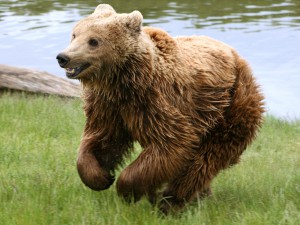 The brown bear used to be a more frequent sight, and there were more of them across the region. Presently, the distribution of the species is determined by the preservation of forest tracts in the northern districts of Gdov, Plyussa, and Strugi Krasniye. In the Pskov and Porkhov districts the encounters are rarer. The animal is a rare sight in the southern forests too. It usually inhabits old coniferous forests, close to moss moors, water bodies, or overgrowing log-sites. Bears are sedentary.
The brown bear used to be a more frequent sight, and there were more of them across the region. Presently, the distribution of the species is determined by the preservation of forest tracts in the northern districts of Gdov, Plyussa, and Strugi Krasniye. In the Pskov and Porkhov districts the encounters are rarer. The animal is a rare sight in the southern forests too. It usually inhabits old coniferous forests, close to moss moors, water bodies, or overgrowing log-sites. Bears are sedentary.
The brown bear is omnivorous. It feeds on young grasses, leaves of aspen and mountain ash, herbaceous plants, berries, mushrooms, honey, and nuts. Animal food includes frogs, lizards, insects, worms, small animals, birds, and carrion. In the milky stage of oats, the bear comes out to crop fields to forage. Cases of bears attacking elks were registered. The species does not attack domestic animals, and avoids encounters with people. Bears winter in dens, in a state of dormancy. It goes to hibernation in October, and revives in March-April. In December-January, mothers give birth to 2-3, and rarely 4 blind cubs of 600-700 grams each.
/ * The photos at lake.peipsi.org are cross-posted from commons.wikimedia.org and are used for familiarization purposes only. No commercial use of the photos is allowed. For more information about to use the photos see the originals on commons.wikimedia.org. /


